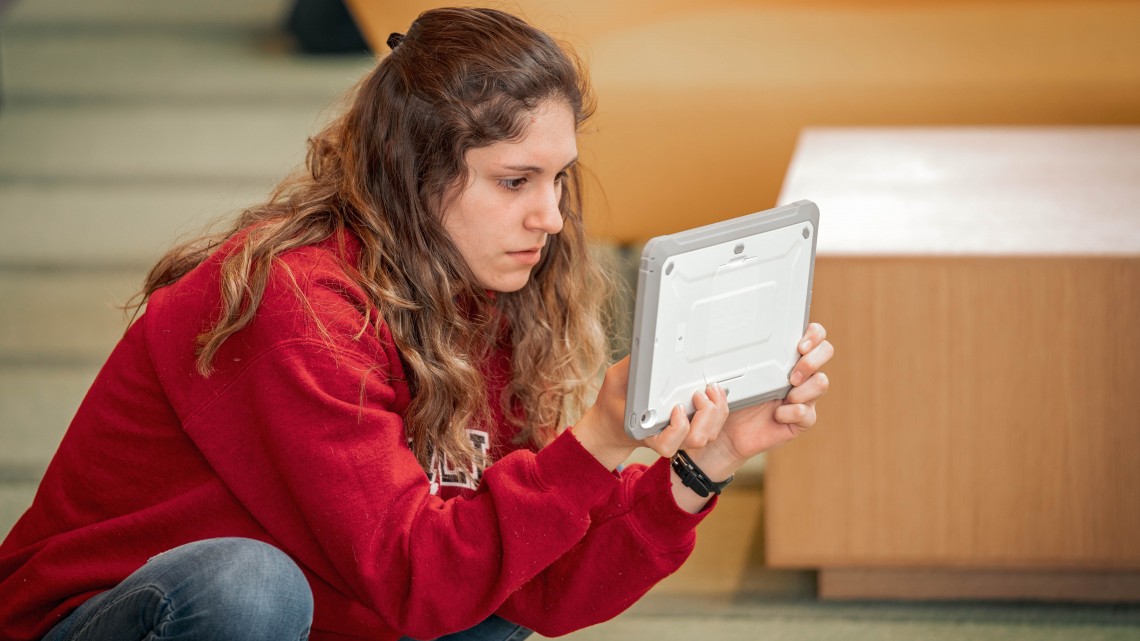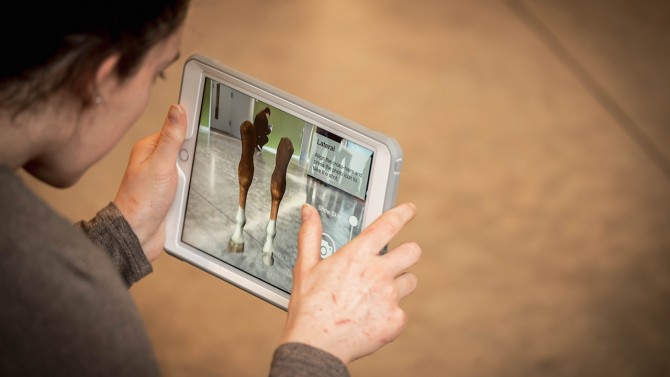
Bianca Ruspi, D.V.M. ’22, crouches in the College of Veterinary Medicine atrium as she practices capturing radiographic views of a simulated horse leg.
Veterinary students’ AR app sparks new level of learning
By Olivia M. Hall
Cornell veterinary students can now get a leg up in learning equine anatomy, thanks to a custom-designed app created at the college.
This spring, the College of Veterinary Medicine’s distribution course, Anatomy of the Horse, was the first to feature the Equine X-Ray Positioning Simulator. The augmented reality app, developed by a team in CVM’s Educational Support Services (ESS), superimposes a digital image of a horse limb onto the surroundings seen through an iPad.
“The students were so excited and seemed to really enjoy the technology,” said Allison Miller ’03, D.V.M. ’07, lecturer in the Department of Biomedical Sciences and the Department of Clinical Sciences, who teaches the eight-week class.
The app is part of the larger educational toolkit that Miller created to help D.V.M. students study parts of the equine musculoskeletal system – a subject students often find challenging. “We try really hard not to teach anatomy as memorization,” Miller said.
Instead, in a “flipped classroom” approach, she first had students complete out-of-class tasks, such as dragging and dropping bone labels onto parts of a horse’s body in a series of online interactive exercises. “The idea is to better prepare them for more meaningful and in-depth classroom discussions,” she said.
In class, students applied their new knowledge to two real-life case scenarios.
“The app came in at this point,” Miller said, “as it allowed them to practice their radiographic positioning for the views that they would take as part of one of the case workups.”
In the CVM atrium in front of the lecture hall, 20 students each used an iPad to project a 3D model of full-size equine thoracic limbs onto the floor. They could walk around the simulation, slide back the skin to reveal the underlying bone structure, position a light beam on the image and capture a series of required radiographic views, which Miller later graded.
“Students can hear a lecture on how to take certain oblique radiographic views, but actually positioning yourself to take them might prove more challenging,” Miller said.
She hopes that working with the app will give them the opportunity to practice and gain mastery and confidence without the need for live animals or the risks associated – for both practitioners and patients – with repeated exposure to X-ray beams. The augmented reality app bridges pre-clinical and clinical content, showing students early in the curriculum why the anatomy they are studying will be important in the field.
At the heart of the app is a 3D model of a horse leg and the underlying skeleton built by CVM medical illustrator and animator Allie Buck.
“Normally,” Buck said, “veterinarians have to crouch down to radiograph the distal equine limbs, so I made my model life-size, hoping that students would naturally feel the need to kneel or crouch down to take their radiographs. And they did.”
Students in the class loved the new approach to learning.
“The app was amazing,” said Tyler Olson, D.V.M. ’22, who had used augmented reality devices outside of the educational context. “I found it to be pretty self-explanatory and user-friendly.”
Students responded overwhelmingly that they found the app and out-of-class exercises to be helpful.
“I had never used any augmented reality device, so I was blown away by how realistic it was,” said Stephanie Bandoski, D.V.M. ’22. “It was a lot of fun taking X-rays with instant gratification, since you knew immediately if you were angled at the right position. I’m very thankful Dr. Miller and the ESS team put in the effort to make this happen.”
Given the positive feedback, Miller said she hopes to integrate more augmented reality exercises into the pre-clinical curriculum.
“I would have loved to have had this app when I was a student, first learning about positioning for equine oblique radiographs and learning the anatomy,” she said. “I’m so jealous of the technology the veterinary students have available to them now to enhance their learning.
“While nothing can fully prepare you for an emergency where you have primary case responsibility and emotions are running high,” she said, “I think we are doing our absolute best to prepare our students while they are here.”
Olivia Hall is a freelance writer for the College of Veterinary Medicine.
Media Contact
Get Cornell news delivered right to your inbox.
Subscribe

